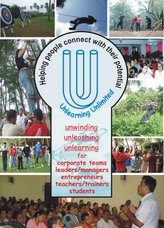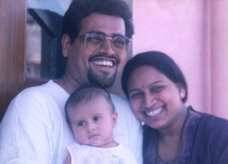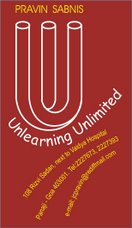In 2001, at the International Goans Convention, the poet with the silver mane enthralled the audience with yet another golden speech. Manoharrai Sardessai was always an inspirational muse to scores of the loyal fans of his poetry, prose and philosophy. On that day, he was speaking about the Konkani quotation “Don Voddeani paim…” (feet in two canoes) which highlighted the futility of doing so. However, Manoharrai was unveiling a new dimension… the ancient Goan tradition of combining two boats to create a larger platform called “sangodd”.
Last Friday, recorded a full year since the demise of Goa’s most adored poets. But his take on things, both, Goan and global, continues to hold immortal inspiration. Manoharrai Sardessai’s poems and songs, speeches and talks, writings and musings continue to be a guiding light as we stand at the crossroads pondering over looming questions. Whether to go global with English in primary education or embrace the mother tongue, Konkani? Whether to stick to the Devanagri script or patronise the Romi script? Whether to pursue development or bother about the environment?
Sardessai’s message of the harmonizing dimension of “sangodd” assumes greater relevance in today’s times when every question arouses diametrically extreme viewpoints that spark off bitterness and hostility. His own life reflected the “sangodd”. Sardessai wrote mature political ballads as well as delightful songs for children. While he wrote extensively in Konkani, Marathi, Hindi and other Indian languages, he also indulged in the mastery of French, English, Portuguese and other international languages. He was a fine teacher who never gave up on studying. He would write about rationalism and socialism and simultaneously pen prayers to Shantadurga and Jesus. He initiated the publishing of his books in both Devanagri and Romi scripts.
Every fight is essentially started over a difference in perceptions. Many such perceptions are based on prejudices. An open mind is one that can combine diverse opinions to create a “sangodd” and develop new dimensions that will foster unity amidst hearts….
With a “sangodd”, it is possible to ride two boats
“Develop new dimensions” to cross every moat…
Monday, June 25, 2007
Monday, June 18, 2007
GOOD WORD!
Ram Puniyani - a Professor in Biomedical Engineering at Indian Institute of Technology, Powai – was pensive. Apart from his teaching and research activities, Ram pursued a parallel track concerned with issues related to social problems, particularly the ones related to preservation of democratic and secular ethos in the country. His European friend who had come-a-visiting noticed his distress and inquired about the cause for his sadness. Ram held out the day’s newspapers and said that he was disturbed by the “communal” incidents in the country.
“Why should “communal” incidents worry you?” the European asked, “communal activities are always welcome”. Their further exchanges and ensuing debate established a serious divergence in what they meant by the word “communal. Ram obviously was talking about oppressive tendencies and actions based on religious fundamentalism and fascism. His friend from across the continent had a totally different meaning of communalism as a word that spoke of a force uniting people into a community.
In most parts of the western world, the word is a modern term that describes a broad range of social movements and social theories which centred on the community. It is about putting the interests of the community above the interests of the individual, and this is done on the principle that the community exists for the benefit of the individuals who participate in it, so the best way to serve the interests of the individual is through the interests of the community. Communalism is also associated with various branches of socialism. The term "communalism" is often used instead of "communism" to denote those communal societies that are not based on Marxism.
However in South Asia the word “communalism” has only negative connotations. The word is used dark shades to denote a force separating different communities based on some form of social or sectarian discrimination. Ram Punyani, who was down in Goa last month, shared the irony of how we have allowed an originally positive word to become part of a dreaded vocabulary.
Mere unlearning of the wrong meaning will not suffice… We need to first explore the dimensions of deep prejudices and negative perceptions based on religion, race, caste, gender and language. We must challenge divisive arguments and develop new dimensions that embrace humane values in our behaviour and talk, too... Only then we will be able to worthy of using the word “communalism” in its rightful context.
“Let’s unlearn the depraved context of the word ‘communalism’
‘Develop new dimensions’ to actualise the principles of humanism!”
Regards
Pravin
“Why should “communal” incidents worry you?” the European asked, “communal activities are always welcome”. Their further exchanges and ensuing debate established a serious divergence in what they meant by the word “communal. Ram obviously was talking about oppressive tendencies and actions based on religious fundamentalism and fascism. His friend from across the continent had a totally different meaning of communalism as a word that spoke of a force uniting people into a community.
In most parts of the western world, the word is a modern term that describes a broad range of social movements and social theories which centred on the community. It is about putting the interests of the community above the interests of the individual, and this is done on the principle that the community exists for the benefit of the individuals who participate in it, so the best way to serve the interests of the individual is through the interests of the community. Communalism is also associated with various branches of socialism. The term "communalism" is often used instead of "communism" to denote those communal societies that are not based on Marxism.
However in South Asia the word “communalism” has only negative connotations. The word is used dark shades to denote a force separating different communities based on some form of social or sectarian discrimination. Ram Punyani, who was down in Goa last month, shared the irony of how we have allowed an originally positive word to become part of a dreaded vocabulary.
Mere unlearning of the wrong meaning will not suffice… We need to first explore the dimensions of deep prejudices and negative perceptions based on religion, race, caste, gender and language. We must challenge divisive arguments and develop new dimensions that embrace humane values in our behaviour and talk, too... Only then we will be able to worthy of using the word “communalism” in its rightful context.
“Let’s unlearn the depraved context of the word ‘communalism’
‘Develop new dimensions’ to actualise the principles of humanism!”
Regards
Pravin
Monday, June 11, 2007
MILKY WAY
“Everything is possible, especially the impossible” – Remo (song – Bombay City )
When I was a child, milk was sold in glass bottles. An aluminum card identified the number of bottles every family was eligible for. However, due to shortage of milk, only one bottle would be given at a time and one had to come back in the queue for another bottle. People would start queuing up at the milk booth, as early as 4 am in the morning, since the early ones improved their chances of getting more bottles… Some started “fixing” their position in the queue by marking their position with a stone; so that they could do other chores till the milk van came… others would throw way these stones and “usurp” a “better” position in the queue.
My childhood was full of incidents of “gentlemen” and “ladies” fighting out, every morning… over missing stones at the milk booth. During those days, if somebody were to say that it was possible to have as much milk as one required, he would be considered a fool or a madman. However, today India is a world leader in the production, distribution and consumption of milk. Today, milk is available in abundance and more importantly at any time of the day, anytime of the year. All this transformation was possible due to the vision of V J Kurien.
Kurien and his team have taught us a very important lesson: nothing is impossible if you are ready to explore new dimensions to what seems to be an unsolvable problem. It is said so well that answers are found in the questions themselves. Kurien identified that the shortage of milk was not in dearth of milk collection. The problem lay with the manipulative exploitation by the private traders and middlemen who controlled the marketing and distribution system. The alternative dimension was developed of milk co-operatives where the farmers were the sellers, with no middle men in between.
Thus the success story of the White Revolution in India was scripted.
The neighbours still fight, but not over milk!
Do not be overwhelmed by the hopeless situation,
Unravel the question to “develop new dimensions”!
Regards
Pravin
When I was a child, milk was sold in glass bottles. An aluminum card identified the number of bottles every family was eligible for. However, due to shortage of milk, only one bottle would be given at a time and one had to come back in the queue for another bottle. People would start queuing up at the milk booth, as early as 4 am in the morning, since the early ones improved their chances of getting more bottles… Some started “fixing” their position in the queue by marking their position with a stone; so that they could do other chores till the milk van came… others would throw way these stones and “usurp” a “better” position in the queue.
My childhood was full of incidents of “gentlemen” and “ladies” fighting out, every morning… over missing stones at the milk booth. During those days, if somebody were to say that it was possible to have as much milk as one required, he would be considered a fool or a madman. However, today India is a world leader in the production, distribution and consumption of milk. Today, milk is available in abundance and more importantly at any time of the day, anytime of the year. All this transformation was possible due to the vision of V J Kurien.
Kurien and his team have taught us a very important lesson: nothing is impossible if you are ready to explore new dimensions to what seems to be an unsolvable problem. It is said so well that answers are found in the questions themselves. Kurien identified that the shortage of milk was not in dearth of milk collection. The problem lay with the manipulative exploitation by the private traders and middlemen who controlled the marketing and distribution system. The alternative dimension was developed of milk co-operatives where the farmers were the sellers, with no middle men in between.
Thus the success story of the White Revolution in India was scripted.
The neighbours still fight, but not over milk!
Do not be overwhelmed by the hopeless situation,
Unravel the question to “develop new dimensions”!
Regards
Pravin
Monday, June 4, 2007
DEADLY DIMENSION!
A week ago, IBN-7 telecast a macabre story about a faith healer claiming cure for any disease, performing surgeries with swords, using Handiplast as bandages and making patients drink his blood. Shockingly, quackery is not just a rural phenomenon; it is rampant in the by lanes of our cities, too. Why do people trust quacks, Godmen and the so-called faith healers? Is it the lack of adequate scientific and rational solutions or simply orthodoxy?
In a country where multi-specialty hospitals abound and medical tourism is a growing business, it is a grim fact that lack of adequate healthcare at the implementation level results in quacks exploiting vulnerable masses. However, healthcare and health infrastructure are not the only reasons. The quacks thrive even where doctors are abundant. The problem is political. All political parties shy away from legislating the anti-quackery bill. After all, numbed minds are more easily captured for voting.
So why is it that Indians are easily convinced of miracles? Tricksters in the garb of religious leaders influence city masses as much as their country cousins. Without any knowledge of medicine they say they can cure ailments like cancer, AIDS and what not. While quackery is one dimension of blind faith, faith healing seems to be the most popular one. Look around to notice the mushrooming of divine retreat centers.
The argument in favour of faith healing is that it can’t be written off completely since it could help create an aura of positivity to help cure – along with scientific methods – diseases like cancer. Faith and courage help in healing. It helps body to generate immunological and other mechanism to fight the disease. However, what goes on the name of faith healing is a humbug born of cheating and exploitation.
Faith is a mechanism of the mind. It is born of optimistic resolve undeterred by fear. But when this belief is based on external influences impressed by trickery or blinded by pseudo-sciences, then the owner of such beliefs is weakened psychosomatically. Such a person becomes uni-dimensional and can be easily taken advantage of… and thus be psychologically enslaved! The deadly dimension of blind faith has to be challenged and the liberating dimension of scientific temper must be empowered.
While faith and courage ameliorate, faith-healing is an impediment
“Develop new Dimensions” to become truly free and independent!
Regards
Pravin
In a country where multi-specialty hospitals abound and medical tourism is a growing business, it is a grim fact that lack of adequate healthcare at the implementation level results in quacks exploiting vulnerable masses. However, healthcare and health infrastructure are not the only reasons. The quacks thrive even where doctors are abundant. The problem is political. All political parties shy away from legislating the anti-quackery bill. After all, numbed minds are more easily captured for voting.
So why is it that Indians are easily convinced of miracles? Tricksters in the garb of religious leaders influence city masses as much as their country cousins. Without any knowledge of medicine they say they can cure ailments like cancer, AIDS and what not. While quackery is one dimension of blind faith, faith healing seems to be the most popular one. Look around to notice the mushrooming of divine retreat centers.
The argument in favour of faith healing is that it can’t be written off completely since it could help create an aura of positivity to help cure – along with scientific methods – diseases like cancer. Faith and courage help in healing. It helps body to generate immunological and other mechanism to fight the disease. However, what goes on the name of faith healing is a humbug born of cheating and exploitation.
Faith is a mechanism of the mind. It is born of optimistic resolve undeterred by fear. But when this belief is based on external influences impressed by trickery or blinded by pseudo-sciences, then the owner of such beliefs is weakened psychosomatically. Such a person becomes uni-dimensional and can be easily taken advantage of… and thus be psychologically enslaved! The deadly dimension of blind faith has to be challenged and the liberating dimension of scientific temper must be empowered.
While faith and courage ameliorate, faith-healing is an impediment
“Develop new Dimensions” to become truly free and independent!
Regards
Pravin
Subscribe to:
Comments (Atom)



